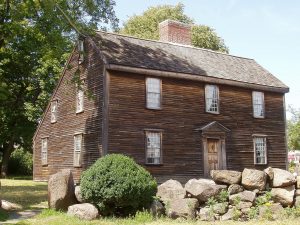The house that is famously known as John Adams’ birthplace stands at 133 Franklin Street in Quincy, Massachusetts. This saltbox-style house is also where the second president of the United States grew up. It is located roughly ten miles to Boston’s south.
The house was originally built in 1681 by Joseph Penniman, and he had his family live there until 1720, when John Adams’ father, Deacon John Adams, bought it and the six acres of farm around it.
The house is made of a sturdy wooden frame structure, has two and a half floors, and is overlaid with wooden clapboards. There are two rooms on both sides of the chimney on the second floor, and another two rooms on the ground floor, also on both sides of the chimney. On the first floor, there is also a lean-to portion, where two additional rooms can be found. At the front of the house, the door is located in the center and is bordered by pilasters. Above the doorway are an entablature and a pediment.
The house where John Adams was born is in the middle of a peaceful rural location, where his father cultivated his farm and did his craft of shoemaking. In this quiet place, John learned how to cultivate plants and harvest crops at a young age. He also learned from his father, the love of God. This is also where John’s mother, Susanna Boylston, taught John the ways of elite families from colonial Boston, where she came from.
When John’s father died in 1761, his brother, Peter Boylston Adams, received the house as an inheritance. Meanwhile, John inherited the house that stood nearby, which his father bought in 1744. However, in 1774, John bought the house where he was born from his brother.
At the time of John’s father’s death, the farm measured around 188 acres. The Adams farmed mainly corn on it, but they also grew barley, wheat, oats, and rye. They also kept farm animals like hogs, horses, oxen, and poultry.
The houses continued to be under the ownership of the Adams family until 1893 when they started to rent them out to occupants. While still being owned by the Adams, the Quincy Historical Society made the houses open to the public as house museums in 1893 to 1940.
Today, the houses are operated by the National Park Service and are part of the Adams National Historical Park.
